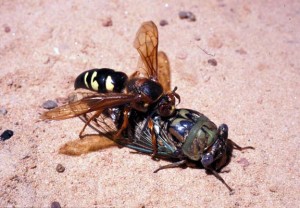A number of wasps (Hymenoptera) are found in landscapes. Females of many species have a stinger, which is their egg laying structure (ovipositor) equipped with a venom sac. Cicada killers and sand wasps are solitary nesting species that dig nesting burrows in turf. Some social wasps such as Southern yellow jackets, and bees such as bumble bees and Africanized honey bees also occasionally nest in the ground. Velvet ants, including cow killers are solitary wasps that are parasitic on ground nesting bees.
Cicada killers, Sphecius speciosus (Hymenoptera: Crabronidae, previously Sphecidae), is a solitary wasp species. They are among several species of “digger wasps” whose females burrow tunnels in soil and provision their nest with prey on which developmental stages or larvae feed. Cicada killers are the largest of the species and mated females find, sting, paralyze and retrieve cicadas (Hemiptera: Cicadadae). The wasps are highly selective in choosing nesting sites and the same locations often are used year after year. They prefer to nest in open areas, but in some locations, build up over years in high numbers due to favorable conditions including nesting habitat and abundant local cicada population levels. Large numbers of wasps occasionally nest in sandy embankments, where they may be a source of concern.


Control options (see Hartup, Townsend 2012) include nesting habitat modification and treating active nest entrances using approved insecticide products a contact insecticide product (Example: a 1% deltamethrin dust product labeled for treating “wasps” in use sites where nests occur such as home perimeters, lawns and bedding areas). Treatments applied to active nests, where the quarter-sized entrance holes and freshly excavated soil occurs will kill adult female(s) that contact the insecticide. However, any eggs laid or developing larvae already present will be unaffected and emerge the next year. Insecticides should temporarily suppress nesting activities. Care should be taken when applying insecticides to avoid being stung.
What about male wasps?
Cicada killer larvae spend the winter months feeding on paralyzed cicadas as they develop through their growth stages, called instars, before pupating within their underground galleries. Timed with emergence of their prey, cicadas, male and female wasp adults emerge from the ground. Males are occasionally very abundant. In a property in Kingwood, TX, (watch video) 72 males were collected using a butterfly net in 2 ½ hours, July 30, 2012, whereas only 2 females were collected using modified plastic bottle traps placed on nesting holes! . Male wasps look superficially like the female wasps but cannot sting. The only visible difference besides her larger size seems to be the spurs attached to the end of the female’s hind leg tibial segment. Stingers on female wasps double as the egg laying structure or ovipositor with a venom sac attached. However, they are very territorial and fight with other males in search of females to mate. They do have a spine that appears to be a stinger, but it is harmless. They rarely land and only perch temporarily on objects, so they are unaffected by treatments to active nesting entrances. The only way to reduce the populations of male wasps in a nesting area is to catch them or hit them with a tennis or badminton racquet one at a time!
References
Hartup, W. 2012. Watch out for the cicada-killer! Forsyth and Stokes County Cooperative Extension, NCSU
Townsend, L. 2012. Cicada Killer wasps. ENTFACT-004, Cooperative Extension Service, University of Kentucky .

